I do a lot of my deer hunting with a muzzle-loading rifle. I usually take at least as many—if not more—deer each season with a muzzle-loader as I do with a center-fire rifle. Part of the reason for that success rate is that in Virginia we have an “early” muzzle-loading season, a couple of weeks before the main firearms season begins. In those two weeks the deer haven’t been hunted much; they tend to be somewhat less alert than later on when more hunters are in the woods. (We have a "late" muzzle-loader season as well, and it's a tough one: since it comes after the main firearms season, 20-25% of the deer are dead, with the stupid and unlucky ones cleaned out.)
I’m not going to get into the old argument about which is “better,” in-lines traditional sidelocks. But having owned and used both classes of muzzle-loaders, I’ll discuss the ones I’ve owned and at the end very briefly comment on what I think of as the virtues and drawbacks of both. There’s no doubt whatever that these days in-line users are in the majority and that people who shoot sidelock rifles are fewer and fewer each year.
A little history is in order here. Virginia first instituted a season specifically for muzzle-loading hunters in 1973. I was surprised to learn this after checking the web site for the Department of Wildlife Resources. The idea of this first special season was to emulate The Good Old Days of the pioneers: in keeping with that concept DWR required that the rifle had to be a sidelock type using either flint or percussion ignition. Only iron sights were allowed. That initial muzzle-loading season followed the main gun season, and it applied only west of the Blue Ridge. Hunters east of the Ridge were out of luck. These requirements meant, quite frankly, that very few people bothered with muzzle-loader hunting at all, unless they were really into primitive weapons. Many of them “dressed the part,” looking like Davy Crockett or Daniel Boone.
Remember also that in the early 1970’s there were nowhere near so many deer in Virginia as there are today. Deer hunting with a center-fire rifle is tough enough; using a muzzle-loader made it that much harder. Only a small number of people took advantage of the special season; they really weren’t a significant factor in the overall kill. In 1973 a total of only a few more than 50,000 deer were taken statewide. Of those, only 24 were taken with muzzle-loaders. Today four or five times that many deer get tagged: the peak was in 2009, with well over a quarter-million taken.
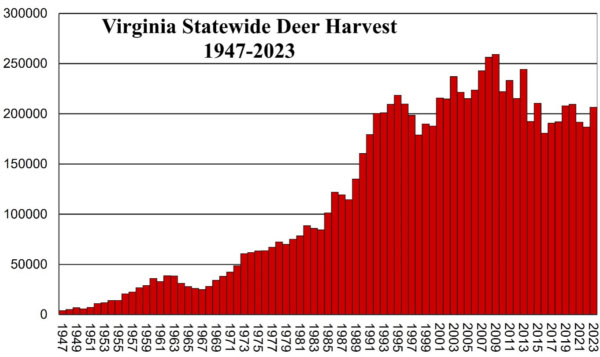
Things began to change in the late 1980’s. The deer herd was rebounding, providing DWR with an incentive to expand hunting opportunities. By 1990 muzzle-loader hunting became allowed statewide. That new special season greatly increased the number of muzzle-loader hunters, even though the DWR simultaneously instituted a special muzzle-loader hunting license. Over 38,000 such licenses were issued.
In 1990 Sunday hunting was still prohibited—an idiotic Blue Law that has since gone by the board—so that effectively for many people only one hunting day a week was available, i.e., Saturday. The new season therefore increased the number of days available to hunt. Since Virginia’s deer herd was growing by leaps and bounds (ha, ha) it was partly to increase the total kill that this change to a special season was made. Still, even in 1990 the rules continued to mandate only sidelock guns with iron sights. But the rapid nationwide popularization of in-line rifles led to pressure on DWR to permit them here. It took a while but in 1993 they caved: in-lines were permitted but even so, they still had to have iron sights. This iron-sights-only rule was pretty unpopular: in 1995 under intense pressure, DWR finally allowed the use of telescopic sights. At that point the muzzle-loader season really took off. Suddenly hunters using muzzle-loaders, who had been a relatively minor segment of the hunting population, vastly increased in numbers.
Most people who got into muzzle-loader hunting in the early 90’s didn’t give a poot about re-creating Pioneer Days: they just wanted a few extra days to hunt deer. I was one of them. I was still working at that time, couldn’t hunt on Sunday, so the new season added a couple of hunting days to my opportunity.

I bought my first muzzle-loader in kit form at a local discount store. That would have been in 1990 or 1991: it was a cheap CVA “Blazer” in .50 caliber rifled 1:66” hence suited only to round balls. That was OK with me. Lewis and Clark got all the way to the Pacific and back using round balls, dealing with grizzly bears, elk, and moose: a Virginia whitetail wasn’t going to laugh at a round ball.
The Blazer was, to be charitable, a pretty lousy rifle. It was also potentially dangerous because the nipple that ignited the powder was directly in front of my right eye. Although I never had any problems with it myself, had that nipple come loose somehow it would have at least blinded me on one side and could possibly have killed me. Round balls shot reasonably well out of it thanks to its slow twist rate; moreover they were fully as lethal they needed to be. I ended up killing three deer with the Blazer before deciding I wanted something better.
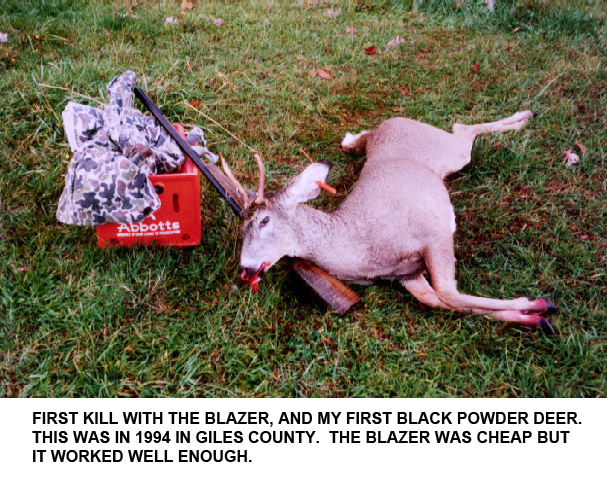
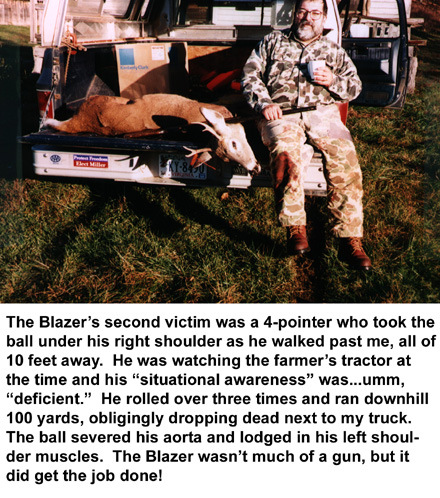
“Something better” was a Thompson/Center “New Englander,” a sidelock percussion gun rifled 1:48” so that it could be used with round balls or conicals. A friend and hunting partner had bought a New Englander. I was very impressed with T/C’s quality of manufacture and his rifle’s accuracy.
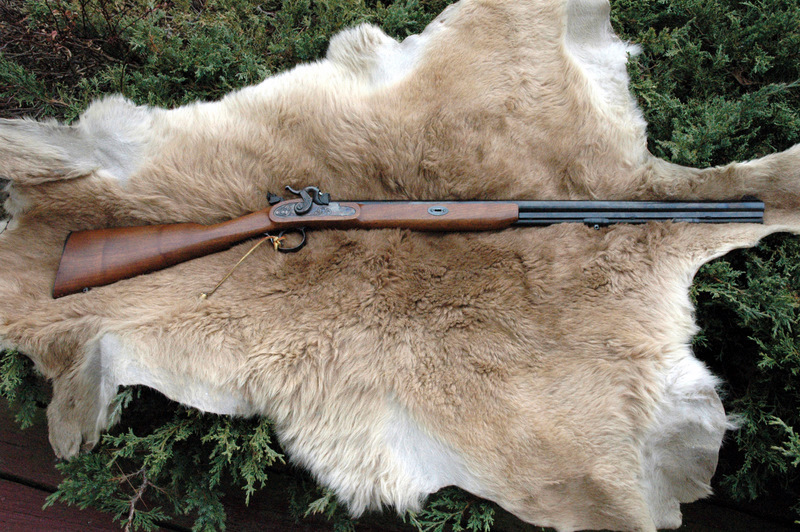
Thinking that someday I might want to hunt something bigger than whitetails I opted for a .54, though. I fitted it with a peep sight to replace the open sight that came from the factory. In the years I used it, I took something like 18 deer with it, took it to Namibia, and killed a big warthog as well.

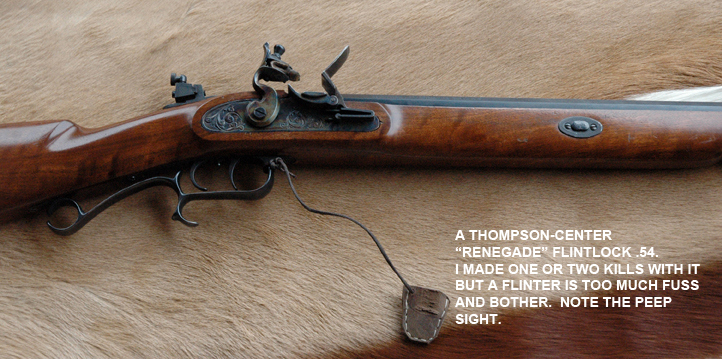
I wanted to try a flintlock. I stuck with the .54, finding a near-new “Renegade” T/C, with which I killed one or two deer. But flintlocks are—to be charitable—a pain in the ass. There are all kinds of fiddly bits of kit you have to have to make it go BANG!, many more fiddly bits than even a percussion muzzle-loader requires. In time I found someone else who wanted a flintlock, so he bought it from me.



There is always something bigger and better to try. I decided to see what I could do with a .58. In the fullness of time I bought several such in succession. One was an Ithaca-made “Hawken” with which I made one kill; another was a Civil War style “musketoon” that shot well but I never killed anything with it. The third was a truly awful H&R “Huntsman” break-open style rifle that misfired nearly every time if I didn’t hold my mouth right. T/C also made their “Big Boar” Hawken style gun in .58. A truly awesome piece of hardware, one that is very hard to find, but I found one eventually. But in time all my .58’s got sold.

I even owned and used a .32 squirrel rifle at one point. I had a bad scare with that rifle: I was sitting in the woods with it when a Mama Bear and three cubs came ambling by, about 50 feet away. Thank goodness the wind was in my favor and I was doing my invisible act: she didn’t know I was there, armed only with a single-shot muzzle-loader in a pipsqueak caliber. Had she decided I was a threat to her cubs I likely would not be writing this essay. That .32 got sold not long after.

When planning a trip to Namibia I wanted to use a classic: a double rifle. I bought a flat-out drop-dead gorgeous Pedersoli in .72 caliber, one of the slickest guns I’ve ever owned. But I couldn’t shoot the damned thing, not even with a peep sight, let alone the open sights that came on it. I never got to the point with it that I felt comfortable pointing it at an animal, though I tried. I took it to Tennessee for a pig hunt, missed a hog at all of thirty yards; tried it in our local woods and missed a deer at a similar distance. In time it too was sold on to someone who I hope, tamed it and got it to shoot as well as it looked.
I was getting too many calibers to keep up with. I had a .32, a .50, two .54’s, two or three .58’s and the .72; things were getting logistically complicated. Common sense demanded “rationalization” so I decided that .54 caliber was the best way to go: one can do anything with a .54 that can be done with a .50, plus my days of hunting really big stuff in Africa are over.
I still had that first Blazer. I gave it to a young man who’d done some tree-trimming for me. I sort of regretted losing it since I made my first muzzle-loader kills with it. I found another one and bought that but didn’t keep it long. CVA was having a recall program for the Blazer, probably because they didn’t want to get sued if someone lost an eye. I sent the second Blazer to them in exchange for a brand new in-line, a .50 “Wolf.” I never even fired that one: since I had only about $85 in it I gave it to a friend who “needed” a muzzle-loader.
As I have aged my eyes have reached the point where any kind of iron sights are frustrating to use. I had several misses with the New Englander and the flintlock. I refused to scope the New Englander because it was too pretty, and because a scoped sidelock…well, it wasn’t “traditional.” I decided that I would try going over to The Dark Side, buying a used Traditions .54 that was intended to use sabot bullets (rifled 1:20”) but found it impossible to load after it had been fired even once. That one got cleaned up and moved on to someone else.
But I still wanted to try an in-line. I spotted a T/C “Firehawk” in .54 on the Kittery Trading Post web site. Being familiar with T/C’s quality I took it off the market: I’m glad I did. It was in stainless steel, had scope mount bases, and the price was right. I had a nice Burris “Timberline” 4x scope that would work well. The bore condition was acceptable, though hardly pristine.
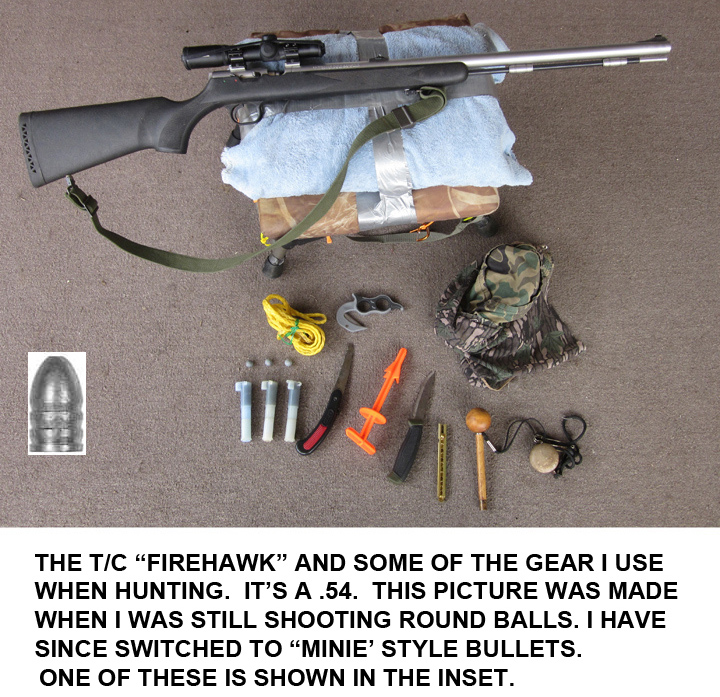
At that point I was still shooting round balls. The Firehawk is rifled 1:38” which is actually a bit too fast for them, but it shot well enough that I could use it at the short ranges in our local woods. In the first two seasons I owned it that Firehawk killed three deer, all with round balls. At the end of last year’s deer seasons I thought I should give Minié bullets a try. That style of projectile dates to before the Civil War. It has a hollow base and is a bit under-sized, to facilitate quick reloads. The theory is that when the powder explodes it will expand the “skirt” into the rifling. That is the case. In that 1:38” rifling those Minié bullets really shine. The Firehawk will shoot 1.5 MOA with them, better than it ever did with round balls.
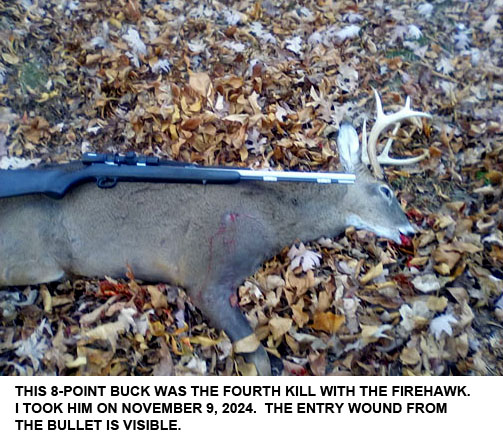
This year I had the first opportunity to take the Firehawk out for a hunt with the Minié bullets. They weigh 439 grains, much heavier than a round ball. I use modest charges, 80 grains of GOEX FFg. On November 9 th of this year a really careless 8-point buck stepped out in front of me, 25 yards away, and got shot. He is now in the process of becoming hamburger, and I am no longer a skeptic about scoped in-lines. For someone with less-than-perfect vision, this non-traditional style of rifle really does the job. I’m now down to two muzzle-loaders, both .54’s. The New Englander sits in the gun safe in honored retirement, the Firehawk is on the job.
After having owned and shot this multiplicity of muzzle-loaders, I’ve come to some conclusions about both types. Again, it’s not my intention to say which is better: that debate will go on and on, probably long after I’m dead. Both types have good and bad points.
Let me begin this section by saying that ballistically there is little to choose between them. Yes, I know that there are some rifles designed to use smokeless powder instead of black powder (or one of the “replica” powders) whose performance approaches that of conventional center-fire rifles. I’m leaving them out of the discussion deliberately. They load from the muzzle, true, but that’s really the only similarity. I’m also not going to include freakish ideas like the Traditions “Nitrofire” rifle that uses a Federal “Firestick.” That’s what would really be called a “breech/muzzle-loader” because while the bullet might be loaded through the muzzle, the powder charge isn’t. It’s a silly gimmick intended to circumvent the rules about muzzle-loading guns in various states.
Conventional sidelock guns, either flint or percussion, have the advantage of traditional appearance; some of them are works of amazing craftsmanship as well. They aren’t mass-produced cookie-cutter in-lines. There are people who value this trait (I’m one) and it’s not to be dismissed lightly. In this respect I have to say that my Pedersoli double rifle, as frustrating as I found it to be, was probably the most beautiful gun I’ve ever owned.
If you want a new-made .54, sidelock guns are your only option. Nobody, and I mean nobody, makes a .54 in-line. There are some around on the used-gun market. That’s where I found my Firehawk. Those of us who like the .54 caliber have been bypassed by the gun makers: everyone wants a .50 these days. If you can use open or peep sights sidelock guns are the way to go.
That said, sidelock guns can have some issues. In most of them the flash that sets off the main charge has to “turn the corner” from a drum into the chamber. This can lead to misfires. While misfires aren’t unknown in any muzzle-loader, even in in-lines (the very first time I pulled the trigger on a deer with my Blazer it misfired) they’re nowhere near so common as in sidelocks. Anyone choosing a sidelock needs to thoroughly wring it out at the range to determine its quirks and idiosyncrasies before setting out to kill something.
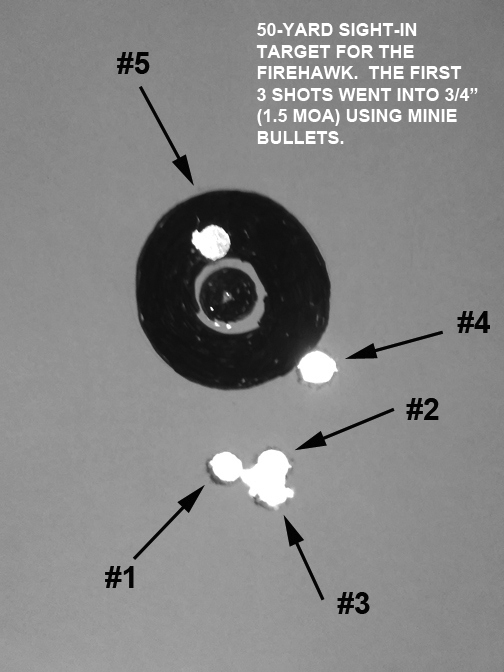 I was skeptical about in-lines, especially scoped ones, for a very long time, but now, having made four kills with my Firehawk, I have changed my mind. It’s very reliable, very accurate, and hits like Thor’s Hammer with those big Minié bullets. I might stick with round balls should I take the New Englander out again, but as the horizon of my hunting life draws nearer, probably I’ll keep using the Firehawk.
I was skeptical about in-lines, especially scoped ones, for a very long time, but now, having made four kills with my Firehawk, I have changed my mind. It’s very reliable, very accurate, and hits like Thor’s Hammer with those big Minié bullets. I might stick with round balls should I take the New Englander out again, but as the horizon of my hunting life draws nearer, probably I’ll keep using the Firehawk.
Sidelock guns can be difficult to clean, but most of them aren’t too bad. In-lines are usually easier because in most of them there’s a removable breech plug that permits easy cleaning. Unfortunately my Firehawk isn’t one of them. The Firehawk was probably T/C’s first venture into in-lines; I suppose that when they decided to get into the game they extrapolated from their sidelock design experience. It doesn’t have a removable breech plug, which mimics the situation with sidelocks. Cleaning the Firehawk is a PITA, since it’s scoped. I have to cover the scope with plastic bags to prevent water damage.
I use real black powder, not a “replica” powder. It’s far easier to ignite than “replica” powders. The use of a shotgun primer to ignite the charge isn’t necessary. I use musket caps, though the common #11 caps also work. If real black powder gives lower velocities than replica powders, well, that’s not a problem for me. Most Americans are obsessed with velocity as the sole measure of rifle performance, but in my experience momentum is a far more important parameter. Big, slow-moving bullets kill very well, without doing much meat damage. After 70-odd kills with some sort of muzzle-loader I can assert this is the case with confidence. Make a hole half an inch or more through an animal and he isn’t going anywhere. Heavy bullets at moderate speeds usually go completely through: this is especially the case with the .54 caliber, though even with a .50 it happens more often than not.
One very real advantage to muzzle-loaders of any kind is that the Federal government doesn’t regard them as “firearms” in the same sense as conventional rifles. Although some states do restrict them, most don’t: they can usually be purchased without restrictions and sent to the buyer directly.
| OPENING PAGE|
|SEASON LOGS |
| HUNTING | GUNS | DOGS |
| FISHING & BOATING | TRIP REPORTS | MISCELLANEOUS ESSAYS |
| CONTRIBUTIONS FROM OTHER WRITERS|
| RECIPES |POLITICS |